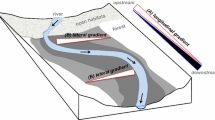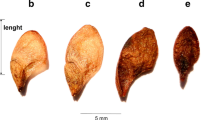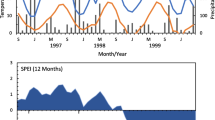Abstract
Following the environmental sieve concept, the setting in which the recruitment of Taxodium distichum occurs in, becomes increasingly restrictive from the seed to seedling stage in an impounded forested wetland. Although a wide elevational band of dispersing seed moves across the boundary of a swamp-field in the water sheet, the zone of germination is relegated to that portion of the forested wetland that draws down during the growing season. Seedling recruitment is further restricted to the uppermost zone of the winter water sheet. These patterns are likely applicable to other species of dominant swamp species, e.g., Cephalanthus occidentalis crossed the boundary of a forested wetland and abandonded field in winter flooding (November–December and November–March, respectively) in Buttonland Swamp. The elevation of the boundary was 101.3 m NGVD. While the seeds of at least 40 swamp species were dispersed across the boundary, few viable seeds were dispersed after the winter season. Kriged maps showed seeds of T. distichum and C. occidentalis dispersed in patches in the water depending on the position of the water sheet. Most species of both water- and gravity-dispersed species had a localized pattern of seed distribution (either spherical or exponential) and this indicated that seeds may not be dispersed for great distances in the swamp. Water-dispersed T. distichum and C. occidentalis had larger dispersal ranges (A 0=225 and 195 m, respectively) than Bidens frondosa and B. discoidea (A 0=14 and 16 m, respectively). Seed dispersal varied with season depending on the availability of seeds. In Buttonland Swamp, viable seeds typically were dispersed for T. distichum in November–June, and for C. occidentalis in November-July. Low water occurred in August 1993 and high in February 1994 (99.8 and 101.6 m NGVD, respectively). The seed banks along the landscape boundary varied in species composition according to elevation (r 2 = 0.996). While the similarity of species richness between water-dispersed seeds and the seed bank at elevations that flooded (during June 1993 through May 1995) was high (10–17%), it was low between water-dispersed seeds and the seed bank at elevations that did not flood (5%). T. distichum seeds had a short germination window in that seeds germinated within a year following their production in zones that were flooded in the winter followed by drawdown during the next growing season. After 1 year, less than 5% of the T. distichum seeds remained viable on the surface of the soil. Germination of T. distichum was confined to specific elevations (above 99.3 but below 101.6 m NGVD) during this study with 4.1% of the seedlings surviving for more than 2 years at a mean of 101.4 m NGVD. All seedlings below this elevation died. To maximize natural regeneration along the boundaries of swamps in abandoned farm fields targeted for restoration, this study suggests a flood pulse regime consisting of high water in the winter to maximize dispersal of live seeds followed by low water in the summer to facilitate seed germination and seedling recruitment. Hydrologic restoration could assist in the natural recovery of damaged wetlands if a seed source exists nearby.
Similar content being viewed by others
References
Barrat-Segretain, M. H. 1996. Strategies of reproduction, dispersion, and competition in river plants: a review. Vegetatio 123: 13–37.
Baskin, C. C. & J. M. Baskin. 1998. Seeds: ecology, biogeography, and evolution of dormancy and germination. Academic Press, San Diego.
Bonis, A. & Lepart, J. 1994. Vertical structure of seed banks and the impact of depth of burial on recruitment in two temporary marshes. Vegetatio 112: 127–139.
Brown, D. 1992. Estimating the composition of a forest seed bank: a comparison of the seed extraction and seedling emergence methods. Can. J. Bot. 70: 1603–1612.
Buckley, R. & Harries, H. 1984. Self sown wild-type coconuts from Australia. Biotropica 16: 148–151.
Cache River Drainage Commissioners of Illinois. 1905. Report of Board of Cache River Drainage Commissioners of Illinois. Illinois Printing Company, Danville, Illinois.
Deutsch, C. V. & Journel, A. G. 1992. GSLIB geostatistical software library and user' guide. Oxford University Press, New York.
Dorge, C. L., Mitsch, W. J. & Wiemhoff, J. R. 1984. Cypress wetlands in southern Illinois. Pp. 393–404. In: C. Ewel and H. T. Odum (eds), Cypress swamps. University of Florida Presses, Gainesville.
Gamma Design Software. 1998. GSC geostatistics for the environmental sciences, Version 3.11.6. Gamma Design Software, Plainwell, Michigan.
Garwood, N. 1989. Tropical soil seed banks: a review. Pp. 149–209. In: Leck, M. A., Parker, V. T. & Simpson, R. L. (eds), Ecology of soil seed banks. Academic Press, San Diego.
Gleason, H. A. & Cronquist, A. 1991. Manual of vascular plants of northeastern United States and adjacent Canada. New York Botanical Garden, Bronx, New York.
Grime, J. P. & Hillier, S. H. 1992. The contribution of seedling regeneration to the structure and dynamics of plant communities and larger units of landscape. Pp. 349–364. In: Fenner, M. (ed.), The ecology of regeneration in plant communities. C.A.B. International, Wallingford, UK.
Guilkey, P. C. 1965. American elm (Ulumus americana L.). Pp. 725–731. In: Fowells, H. A. (ed.), Silvics of forest trees of the United States. USDA agricultural handbook, United States Department of Agriculture, Washington, D.C.
Haan, C. T. 1977. Statistical methods in hydrology. Iowa State University Press, Ames, Iowa.
Hansen, A. J., Risser, P. G. & di Castri, F. 1992. Epilogue: biodiversity and ecological flows across ecotones. Pp. 423–438. In: Hansen, A. J. & di Castri, F. (eds), Landscape boundaries: consequences for biotic diversity and ecological flows. Springer-Verlag, New York.
Harper J. L. 1977. Population biology of plants. Academic Press, London.
Henebry, G. M. 1995. Spatial model error analysis using autocorrelation indices. Ecol. Modelling 82: 75–91.
Houle, G. 1995. Seed dispersal and seedling recruitment: the missing link(s). Ecoscience 2: 238–244.
Houle, G. 1998. Seed dispersal and seedling recruitment of Betula alleghaniensis: spatial inconsistency in time. Ecology 79: 807–818.
Johnson, W. C. 1994. Woodland expansion in the Platte River, Nebraska: patterns and causes. Ecol. Monographs 64: 45–84.
Jones, R. H., Sharitz, R. R., Dixon, P. M., Segal, D. S. & Schneider, R. L. 1994. Woody plant regeneration in four floodplain forests. Ecol. Monographs 64: 345–367.
Journel, A. G. 1987. Geostatistics for the environmental sciences. Environmental Monitoring Systems Laboratory, Las Vegas, NV.
Junk, W. J., Bayley, P. B. & Sparks, R. E. 1989. The flood pulse concept in river-floodplain systems. Can. Spec. Publ. Fish. Aquatic Sci. 106: 110–127.
Klimas, C. V. 1987. Baldcypress response to increased water levels, Caddo Lake, Louisiana-Texas. Wetlands 7: 25–37.
Leck, M. A. & Graveline, K. J. 1979. The seed bank of a freshwater tidal marsh. Am. J. Bot. 66: 1006–1015.
Legendre, P. & Fortin, M. 1989. Spatial pattern and ecological analysis. Vegetatio 80: 107–138.
Lunt, I. D. 1995. Seed longevity of six native forbs in a closed Themeda triandra grassland. Austr. J. Bot. 43: 439–449.
Lunt, I. D. 1996. A transient soil seed bank for the yam-daisy Microseris scapigera. Victorian Nat. 113: 16–19.
Mahoney, J. M. & Rood, S. B. 1998. Streamflow requirements for cottonwood seedling recruitment – an integrative model. Wetlands 18: 634–645.
McKnight, J. S., Hook, D. D., Langdon, O. G. & Johnson, R. L. 1981. Flood tolerance and related characteristics of trees of the bottomland forest of the southern United States. Pp. 29–69. In: Clark, J. R. & Benforado, J. (eds.), Wetlands of bottomland hardwood forests, Proceedings of a Workshop on Bottomland Hardwood Wetlands of the Southeastern United States, Lake Lanier, Georgia. Elsevier Scientific Publishing Company, Amsterdam.
McVean, D. N. 1955. Ecology of Alnus glutinosa (L.) Gaertn. Part II. Seed distribution and germination. J. Ecol. 43: 61–71.
Middleton, B. A.. 1995. Sampling devices for the measurement of seed rain and hydrochory in rivers. Bull. Torrey Bot. Club 122: 152–155.
Middleton, B. A. 1999. Wetland restoration, flood pulsing and disturbance dynamics. John Wiley and Sons, New York.
Morris, R. C. 1965. Overcup oak (Quercus lyrata Walt.). Pp. 600–602. In: Fowells, H. A. (ed.), Silvics of forest trees of the United States. USDA agricultural handbook, United States Department of Agriculture, Washington, D.C.
Muir, D. B., Hite, R. L., King, M. M. & Matson, M. R. 1995. An intensive survey of the Cache River Basin. Summer 1992. Illinois Environ. Protect. Agency, Marion, Illinois.
Myers, R. S., Shaffer, G. P. & Llewellyn, D. W. 1995. Baldcypress (Taxodium distichum (L.) Rich.) restoration in southeast Louisiana: the relative effects of herbivory, flooding, competition, and macronutrients. Wetlands 15: 141–148.
Negi, A. S., Negi, G. C. S. & Singh, S. P. 1996. Establishment and growth of Quercus floribunda seedlings after a mast year. J. Veg. Sci. 7: 559–564.
Nilsson, C., Gardfjell, M. & Grelsson, G. 1991. Importance of hydrochory in structuring plant communities along rivers. Can. J. Bot. 69: 2631–2633.
Nilsson, C. & Jansson, R. 1995. Floristic differences between riparian corridors of regulated and free-flowing boreal rivers. Regulated Rivers: Res. Manag. 11: 55–66.
Putnam, J. A., Furnival, G. M. & McKnight, J. S. 1960. Management and inventory of southern hardwoods. USDA agricultural handbook 181, Washington, D.C.
Ridley, H. N. 1930. The dispersal of plants throughout the world. L. Reeve & Co., LTD, Ashford, Kent.
Rood, S. B. & Mahoney, J. M. 1990. Collapse of riparian poplar forest downstream from dams in western prairies: probable causes and prospects for mitigation. Environ. Manag. 14: 451–464.
Rood, S. B., Kalischuk, A. R. & Mahoney, J. M. 1998. Initial cottonwood seedling recruitment following the flood of the century of the Oldman River, Alberta, Canada. Wetlands 18: 557–570.
Schneider, R. L. & Sharitz, R. R. 1986. Seed bank dynamics in a southeastern riverine swamp. Am. J. Bot. 73: 1022–1030.
Schneider, R. L. & Sharitz, R. R. 1988. Hydrochory and regeneration in a bald cypress-water tupelo swamp forest. Ecology 69: 1055–1063.
Scott, M. L., Wondzell, M. A. & Auble, G. T. 1993a. Hydrograph characteristics relevant to the establishment and growth of western riparian vegetation. Pp. 237–245. In: Morel-Seytoux, H. J. (ed.), Proceedings of the Thirteenth Annual American Geophysical Union Hydrology Days, Hydrology Days Publications, Atherton, California.
Scott, M. L., Auble, G. T., Friedman, J. M., Ishchinger, L. S., Eggleston, E. D., Wondzell, M. A., Shafroth, P. B., Back, J. T. & Jordan, M. S. 1993b. Flow recommendations for maintaining riparian vegetation along the Upper Missouri River, Montana. National Biological Survey, National Ecology Research Center, Fort Collins, Colorado.
Simpson, R. L., Leck, M. A. & Parker, V. T. 1989. Seed banks: general concepts and methodological issues. Pp. 3–8. In: Leck, M. A., Parker, V. T. & Simpson, R. L. (eds), Ecology of soil seed banks. Academic Press, New York.
Smith, L. M. & Kadlec, J. A. 1985. The effects of disturbance on marsh seed banks. Can. J. Bot. 63: 2133–2137.
Sörensen, T. 1948. A method of establishing groups of equal amplitude in plant sociology based on similarity of species content. K. Dansk. Vidensk. Selsk. Biol. Skrift 5: 2–16, 34.
Sparks, R. E. 1992. Risks of altering the hydrologic regime of large rivers. pp. 119–152. In: Cairns, J., Jr., Niederlehner, B. R. & Orvos, D. R. (eds), Predicting ecosystem risks. Advances in modern environmental toxicology. Volume 20. Princeton Scientific Publishing Company, Princeton, New Jersey.
Streng, D. R., Glitzenstein, J. S. & Harcombe, P. A. 1989. Woody seedling dynamics in an East Texas floodplain forest. Ecol. Monog. 59: 177–204.
TDS. 1994. TDS easy survey plus. Tripod Data Systems,Inc., Corvallis, Oregon.
ter Braak, C. J. F. 1992. CANOCO – a FORTRAN program for Canonical Community Ordination. Microcomputer Power, Ithaca, New York.
Thompson, K. & Grime, J. P. 1979. Seasonal variation in the seed banks of herbaceous species in ten contrasting habitats. J. Ecol. 67: 893–921.
Titus, J. H. 1991. Seed bank of a hardwood floodplain swamp in Florida. Castanea 56: 117–127.
U.S. Fish and Wildlife Service. 1990. Cypress Creek National Wildlife Refuge. United States Department of the Interior, Twin Cities, Minnesota.
Ugent, D., Tindall, D. R. & Doorenbos, N. J. 1981. Big trees of the southern Illinois Cache River bottoms. Phytologia 47: 420–440.
van der Valk A. G. 1981. Succession in wetlands: a Gleasonian approach. Ecology 62: 688–696.
van der Valk, A. G. & Davis, C. B. 1978. The role of seed banks in the vegetation dynamics of prairie glacial marshes. Ecology 59: 322–335.
Vivian-Smith, G. & Stiles, E.W. 1994. Dispersal of salt marsh seeds on the feet and feather of waterfowl. Wetlands 14: 316–319.
Voigt, J. W. & Mohlenbrock, R. H. 1964. Plant communities of southern Illinois. Southern Illinois University Press, Carbondale, Illinois.
Weitzman, S. & Hutnik, R. J. 1965. Silver maple (Acer saccharinum L.). Pp. 63–65. In: Fowells, H. A. (ed.), Silvics of forest trees of the United States. USDA agricultural handbook, United States Department of Agriculture, Washington, D.C.
Wharton, C. H., Kitchens, W. M., Pendleton, E. C. & Sipe, T. W. 1982. The ecology of bottomland hardwood swamps of the Southeast: a community profile. FWS/OBS-81/37, U.S. Fish and Wildlife Service, Biological Services Program, Washington, D.C.
Wichmann, R. F. 1996. A natural history of the Cache River watershed. M.S. Thesis, Southern Illinois University, Carbondale, Illinois.
Williston, H. L., Shropshire, F. W. & Balmer, W. E. 1980. Cypress management: a forgotten opportunity. Forestry Report SA-FR 8, U.S.D.A., Forest Service, Washington, D.C.
Author information
Authors and Affiliations
Rights and permissions
About this article
Cite this article
Middleton, B. Hydrochory, seed banks, and regeneration dynamics along the landscape boundaries of a forested wetland. Plant Ecology 146, 167–181 (2000). https://doi.org/10.1023/A:1009871404477
Issue Date:
DOI: https://doi.org/10.1023/A:1009871404477




